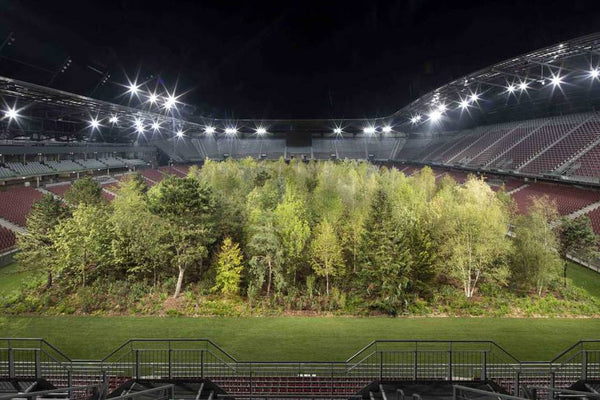Austria's Wörthersee football stadium is now thriving with life in an installation that is as beautiful as it is chilling.
Thirty years ago, Switzerland-based artist Klaus Littmann came across a profound drawing, titled "The Unending Attraction of Nature." The drawing, by Austrian artist and architect Max Peintner, displays an odd dystopian scene in which nature is so detached from the environment that it becomes just a patch, preserved for entertainment. Given that we are currently losing 18.7 million acres of forests each year, Peintner's drawing was prescient, to say the least. And it resonated with Littmann immediately.
"When I first saw the 1970/71 pencil drawing, I was fascinated. I knew that one day this work would be the starting point for a major art project in public space," says Littmann.

"The Unending Attraction of Nature" by Max Peintner
Now, decades later, Littmann has fulfilled the vision with the installation of FOR FOREST: The Unending Attraction of Nature. Blurring the lines between art, architecture, and nature, the installation sets a native central European forest in the midst of Wörthersee football Stadium in Klagenfurt. With nearly 300 trees planted, some weighing up to six tons each, it is Austria’s largest public art installation to date.
The scale and nature of the work brings to mind some of the more monumental moments of the Land Art / Earthworks movement of the 1960s and 70s, in which artists broke out of the gallery to create ecological-themed work on site. (Check out Robert Smithson's Spiral Jetty and Floating Island, two of my favorites, to see what I mean.) But in the face of climate crisis and rampant deforestation, FOR FOREST comes with a more pressing urgency. As explained in a statement about the installation:
"Rallying in support of today’s most pressing issues on climate change and deforestation, FOR FOREST aims to challenge our perception of nature and question its future. It seeks to become a memorial, reminding us that nature, which we so often take for granted, may someday only be found in specially designated spaces, as is already the case with animals in zoos."

The actual creation of the ersatz forest was overseen by landscape architect Enzo Enea and his company, Enea Landscape Architecture. It includes a range of species such as silver birch, alder, aspen, white willow, hornbeam, field maple and common oak. Having opened on September 8, one can imagine it already attracting surprised and happy creatures to the field.
Alas, the installation is not permanent and will close on October 27. In a short video about the work, Littman says his objective was never to make something that would last indefinitely, rather, he says, "My objective is for this picture to remain in people's head for a lifetime."
Fortunately, however, the forest will find a forever home when it is transplanted to a public park nearby. There may no longer be a stadium surrounding it, but it will become part of the landscape and take on a life of its own, no spectators required.
For more information, visit the FOR FOREST website.
Author: Melissa Breyer


